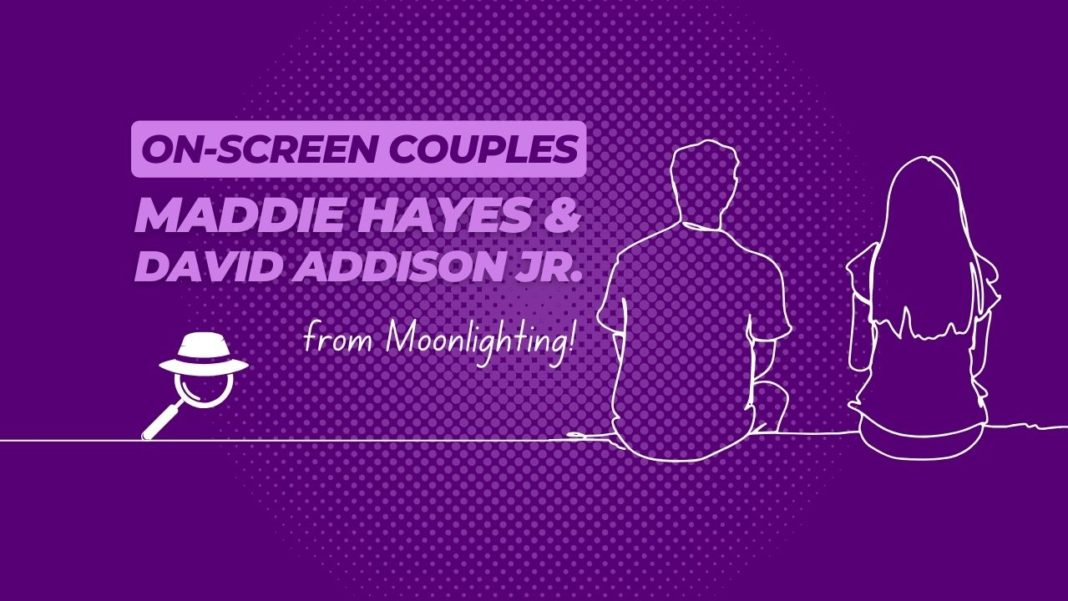Moonlighting emerged in the mid-1980s as a television show that defied conventional genre boundaries, rapidly becoming a cultural phenomenon. Premiering in 1985, it ingeniously blended elements of mystery, drama, romance, and comedy, crafting a formula that was as unpredictable as it was engaging. At its heart, the series followed the antics of Maddie Hayes, a former model who, after a sudden reversal of fortunes, finds herself running a detective agency with the charismatic, irreverent David Addison Jr. This odd pairing, combined with witty dialogue and compelling storytelling, not only captivated audiences but also set a new benchmark for television writing and production. Moonlighting became known for its sharp, fast-paced banter and the palpable chemistry between its leads, pioneering a hybrid of genres that would influence TV narratives for years to come.
The Magic of Maddie and David
Maddie Hayes and David Addison Jr. are central to the allure and enduring appeal of Moonlighting. Cybill Shepherd’s Maddie Hayes is introduced as a poised and elegant former model, whose life takes an unexpected turn when her investment adviser embezzles her fortune. Left with few options, she finds herself at the helm of the Blue Moon Detective Agency. Maddie is initially depicted as sophisticated and somewhat aloof, bringing a sense of class and decorum to the agency’s chaotic environment. Her character undergoes significant development throughout the series, displaying resilience, wit, and a gradually emerging sense of humour that complements her more buttoned-up persona.
Bruce Willis’s David Addison Jr., on the other hand, is the epitome of an easygoing and wisecracking detective. With a penchant for mischief and a devil-may-care attitude, David is the perfect foil to Maddie’s more structured demeanour. His charm and energy bring a light-heartedness to the agency, often leading to impulsive decisions that drive much of the show’s plot. Despite his laid-back approach, David is shrewd and highly capable as a detective, showing depth and sincerity when situations demand it.
Together, Maddie and David create a dynamic that is both electrifying and endearing. Their interactions range from flirtatious banter to profound disagreements, painting a realistic picture of their complex relationship. This chemistry not only fuels the show’s comedic and romantic elements but also underpins the deeper themes of trust, partnership, and personal growth. As they navigate various mysteries and personal challenges, their evolving relationship becomes a compelling narrative arc that resonates with the audience, making them one of television’s most memorable duos.
Chemistry and Conflict
Maddie Hayes and David Addison Jr. of Moonlighting are textbook examples of how intense chemistry and frequent conflict can coalesce into a riveting on-screen relationship, engaging audiences with their evolving dynamic. Their relationship, marked by a magnetic pull and frequent clashes, drove the narrative forward and became a central hook for the audience.
Relationship Dynamics
Maddie and David’s relationship was characterised by a push-and-pull dynamic that kept viewers on the edge of their seats. Early episodes establish a professional respect and a burgeoning friendship underscored by an undeniable attraction. This mix of desire and denial was often played out through snappy dialogues and situational comedy, which became a hallmark of the show. Their differences—Maddie’s cautious and reserved nature versus David’s impulsive and carefree approach—created natural tension and conflict, making their interactions both unpredictable and captivating.
Key Episodes Highlighting Their Dynamics
Several key episodes exemplify their complex relationship dynamics:
“The Dream Sequence Always Rings Twice”
This episode is notable for its black-and-white noir style, where both Maddie and David dream of solving a murder in the 1940s. Each dream explores their perceptions of each other and their relationship, offering deep insights into their fears and desires.
“Atomic Shakespeare”
A playful and highly praised episode where the cast reenacts “The Taming of the Shrew” by William Shakespeare. Here, the themes of romantic conflict and conquest parallel Maddie and David’s own relationship, blending literature with their characteristic banter.
“I Am Curious… Maddie”
This episode is a turning point where Maddie and David confront their feelings after seasons of buildup. The resolution of their pent-up romantic tension shifts the show’s trajectory, deepening their relationship.
Impact on the Show’s Popularity
The chemistry between Maddie and David was a key factor in Moonlighting’s popularity. Their banter and the romantic tension were not just entertaining but also provided a template for future television shows blending romance and comedy. The anticipation of their relationship’s outcomes drove high viewership, with audiences tuning in weekly to catch the latest developments. Their dynamic proved so influential that it impacted how TV shows portrayed mixed-gender partnerships, focusing on witty repartee and complex, layered character development.
Maddie and David’s relationship, with its perfect blend of conflict and chemistry, was fundamental not only to the narrative success of “Moonlighting” but also to its innovative impact on television as a medium. Their interactions redefined viewers’ expectations of what a leading duo could be, making the show a beloved classic in television history.
Innovative Storytelling
Moonlighting is renowned for its innovative storytelling techniques, which played a significant role in distinguishing it from other television dramas and comedies of its time. By breaking the fourth wall, incorporating Shakespearean dialogue, and employing creative narrative devices like tango episodes and dream sequences, the show offered a fresh and unpredictable viewing experience.
Breaking the Fourth Wall
Moonlighting often broke the fourth wall, a technique where characters acknowledge the presence of the audience or make explicit reference to the fact that they are in a TV show. This approach was used to comedic effect, adding an additional layer of wit and engagement. For instance, characters would comment on the script or the delayed production schedule, such as in an episode where David mentions the absence of last week’s episode. This meta-humour not only entertained but also created a complicit relationship between the characters and the audience, making viewers feel like insiders in the jokes and production of the show.
Shakespearean Dialogue and Thematic Episodes
The show’s use of Shakespearean dialogue was epitomised in the episode “Atomic Shakespeare.” Here, the storyline was a playful adaptation of “The Taming of the Shrew,” complete with iambic pentameter and Elizabethan costumes. This not only showcased the versatility of the actors but also highlighted the scriptwriters’ creativity. By integrating high culture with pop culture elements, Moonlighting bridged different literary and dramatic worlds, enhancing its appeal and demonstrating the elasticity of its narrative structure.
Tango Episodes and Dream Sequences
Tango episodes and dream sequences were other hallmark features of Moonlighting’s storytelling. These episodes often diverged stylistically and thematically from the rest of the series, providing surreal or exaggerated interludes that contrasted sharply with the usual narrative arcs. For example, dream sequences like those in “The Dream Sequence Always Rings Twice” allowed the exploration of the characters’ subconscious fears and desires, providing depth and complexity to their personalities and relationships.
Contribution to the Series’ Narrative Style
These elements contributed significantly to the series’ innovative and unpredictable narrative style. By blending various dramatic and comedic techniques, Moonlighting could shift tones seamlessly, maintaining viewer interest through both its episodic and overarching plots. The unpredictability of when and how these storytelling devices would be used kept audiences guessing and engaged, making each episode a unique experience.
The innovative storytelling techniques of Moonlighting not only entertained but also pushed the boundaries of traditional television narratives, setting new standards for creativity and interactivity in the medium.
Behind the Scenes
The making of Moonlighting was as dramatic and intriguing behind the scenes as it was on screen, marked by notable challenges and the dynamic relationship between its lead actors, Cybill Shepherd and Bruce Willis. These off-screen elements significantly influenced the show’s development and the portrayal of the characters’ relationships.
Production Challenges
Moonlighting faced numerous production challenges, primarily due to its ambitious and unconventional scripting and shooting styles. The dialogue-heavy scripts, which included rapid-fire exchanges and intricate wordplay, often resulted in shooting delays. Episodes frequently ran over the usual production time for network TV shows, sometimes requiring up to 14 days to shoot instead of the typical seven. This led to erratic broadcasting schedules, which became a running joke on the show itself.
The high production values and the desire to maintain a cinematic quality in each episode also contributed to frequent delays. These production issues were often stressful for the cast and crew but also fostered a creative environment that pushed the boundaries of standard television production at the time.
Off-Screen Dynamics
The relationship between Cybill Shepherd and Bruce Willis was complex and evolved throughout the series. Initially, there was tension due to differing levels of experience; Shepherd was an established actress, while Willis was relatively new to the scene. However, as the series progressed and Willis’s star rose, the dynamics shifted. Reports suggest that the tension between the lead actors sometimes mirrored the on-screen tension between their characters, adding an element of authenticity to their performances. Despite these challenges, the electric chemistry between Shepherd and Willis was undeniable and became a defining feature of the show.
Influence on On-Screen Portrayal
The off-screen dynamics between Shepherd and Willis had a palpable impact on their on-screen portrayal of Maddie and David. Their real-life rapport and occasional conflicts added depth to their performances, enhancing the believability of their relationship. The natural tension and chemistry helped shape the characters’ interactions, making the romantic and confrontational scenes between them feel more genuine.
Moreover, the challenges of the production process itself—such as delays and script changes—seemed to contribute to the spontaneous and lively feel of the show. The actors’ ability to adapt to these conditions may have added to their dynamic portrayal of Maddie and David’s complex relationship, infusing it with an element of unpredictability and excitement.
Overall, the behind-the-scenes atmosphere of Moonlighting significantly influenced the show’s unique flavour and the iconic status of Maddie and David’s relationship, showcasing how real-life dynamics and production challenges can enhance the creativity and impact of a television series.
Cultural Impact and Legacy
Moonlighting not only entertained audiences during its run but also left a lasting impact on the television landscape, particularly in how romantic relationships and comedic elements are integrated into drama series. The show’s innovative approach and the dynamic between Maddie Hayes and David Addison Jr. set new precedents for character development and narrative structure in television.
Influence on Television Shows
The relationship between Maddie and David in Moonlighting served as a blueprint for many television duos that followed. Their mixture of sharp wit, romantic tension, and complex personal dynamics became a sought-after formula in television storytelling. Shows like The X-Files, with Mulder and Scully’s blend of professional collaboration and unresolved romantic tension, and Castle, featuring another crime-solving duo with a similar dynamic, can trace their roots back to Moonlighting. These series and others adopted the notion that a compelling mix of romance, banter, and professional partnership could drive a show’s narrative and viewer engagement.
Moonlighting also pioneered the concept of an evolving romantic storyline within a typically procedural format. Before Moonlighting, most television series maintained a static relationship dynamic to keep the show’s premise consistent across episodes. However, the evolving relationship between Maddie and David showed that character development and ongoing personal relationships could be central to a show’s appeal, encouraging viewers to invest more deeply in the characters and their journeys.
Shaping Viewer Expectations for Romantic Comedy-Dramas
Moonlighting significantly shaped viewer expectations for romantic comedy-dramas. It demonstrated that audiences could handle, and were enthusiastic about, a mix of drama and comedy that was anchored by a compelling romantic subplot. The show’s ability to weave together light-hearted banter and serious emotional stakes set a high bar for narrative depth and character chemistry that subsequent shows aimed to emulate.
Additionally, the show was one of the first to address the “will-they-won’t-they” romantic tension with a level of sophistication and humour that became a staple in later series. This element kept audiences guessing and more engaged over the series’ lifespan, influencing how future TV romances were crafted. Shows began to integrate similar long-term romantic tensions into their plots, knowing that this could sustain viewer interest and emotional investment across multiple seasons.
Legacy
Moonlighting’s legacy is evident in its contribution to the genre hybridisation in television, blending mystery, comedy, and drama with a romantic core. This approach has influenced countless shows and has become a standard storytelling technique in television. The series also pushed the boundaries of typical narrative formats, experimenting with metafiction and unconventional episodes that challenged viewers’ expectations of what a television show could be.
Overall, the cultural impact and legacy of Moonlighting and the relationship between Maddie and David are profound, continuing to influence the structure and thematic development of television series decades after the show ended. The pioneering spirit of Moonlighting remains a benchmark for creativity and innovation in TV storytelling.
Conclusion
The relationship between Maddie Hayes and David Addison Jr. in Moonlighting remains one of the most memorable and influential aspects of the show, underpinning its lasting appeal and esteemed place in television history.
Why Maddie and David’s Relationship Remains Memorable
Maddie and David’s relationship captivates audiences for several reasons. First, their electric chemistry and rapid-fire banter provided endless entertainment, setting a new standard for dialogues in television. Their exchanges were not only humorous but often layered with emotional depth, reflecting genuine human interactions and complexities. This depth made their relationship feel real and relatable, allowing viewers to emotionally invest in their journey together.
Furthermore, the tension between them, combined with their contrasting personalities—Maddie’s cool elegance versus David’s carefree charm—created a dynamic that was both unpredictable and delightful. This push-and-pull, enriched by excellent performances by Cybill Shepherd and Bruce Willis, kept viewers engaged and rooting for their success, whether in solving cases or navigating their complicated personal lives.
The Series’ Lasting Appeal and Place in Television History
Moonlighting holds a special place in television history, primarily due to its innovative storytelling and the way it reshaped genre boundaries. By successfully blending mystery, romance, drama, and comedy, the show created a hybrid model that has been emulated by countless other series since. Its willingness to experiment with narrative forms—including breaking the fourth wall and incorporating non-traditional elements like Shakespearean dialogue and black-and-white sequences—demonstrated a creative courage that broadened the possibilities within television storytelling.
The series also made significant contributions to the evolution of character development in serialised TV, particularly in how romantic relationships could be portrayed. “Moonlighting” proved that ongoing romantic tension, when skilfully handled, could add significant depth to a series and sustain viewer interest over time. This narrative technique has influenced the structure of many popular series that followed, making Moonlighting a reference point for effective romantic storytelling in television.
Overall, the enduring appeal of Moonlighting lies in its unique combination of humour, heart, and innovation. Maddie and David’s relationship, integral to this mix, remains a defining element of the show, ensuring that Moonlighting continues to be celebrated and studied as a landmark series that forever changed the landscape of television.






